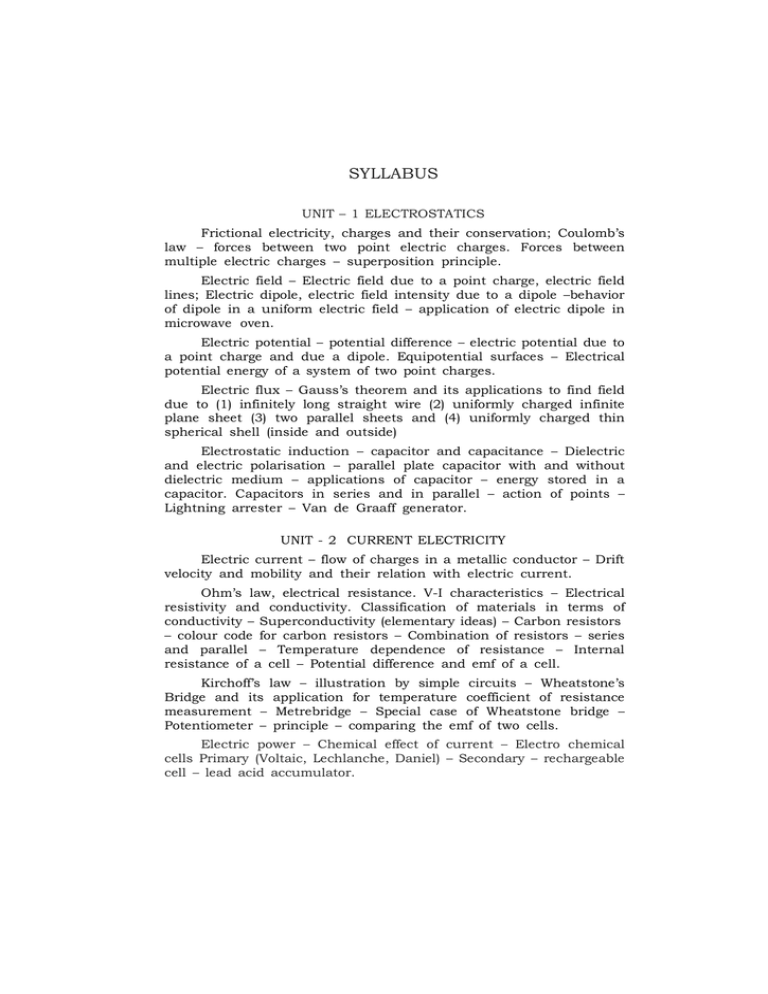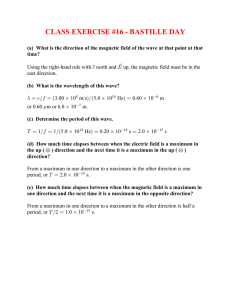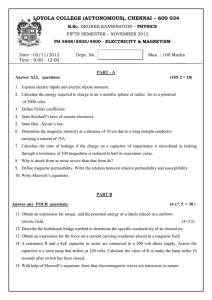Syllabus for Physics
advertisement

SYLLABUS UNIT – 1 ELECTROSTATICS Frictional electricity, charges and their conservation; Coulomb’s law – forces between two point electric charges. Forces between multiple electric charges – superposition principle. Electric field – Electric field due to a point charge, electric field lines; Electric dipole, electric field intensity due to a dipole –behavior of dipole in a uniform electric field – application of electric dipole in microwave oven. Electric potential – potential difference – electric potential due to a point charge and due a dipole. Equipotential surfaces – Electrical potential energy of a system of two point charges. Electric flux – Gauss’s theorem and its applications to find field due to (1) infinitely long straight wire (2) uniformly charged infinite plane sheet (3) two parallel sheets and (4) uniformly charged thin spherical shell (inside and outside) Electrostatic induction – capacitor and capacitance – Dielectric and electric polarisation – parallel plate capacitor with and without dielectric medium – applications of capacitor – energy stored in a capacitor. Capacitors in series and in parallel – action of points – Lightning arrester – Van de Graaff generator. UNIT - 2 CURRENT ELECTRICITY Electric current – flow of charges in a metallic conductor – Drift velocity and mobility and their relation with electric current. Ohm’s law, electrical resistance. V-I characteristics – Electrical resistivity and conductivity. Classification of materials in terms of conductivity – Superconductivity (elementary ideas) – Carbon resistors – colour code for carbon resistors – Combination of resistors – series and parallel – Temperature dependence of resistance – Internal resistance of a cell – Potential difference and emf of a cell. Kirchoff’s law – illustration by simple circuits – Wheatstone’s Bridge and its application for temperature coefficient of resistance measurement – Metrebridge – Special case of Wheatstone bridge – Potentiometer – principle – comparing the emf of two cells. Electric power – Chemical effect of current – Electro chemical cells Primary (Voltaic, Lechlanche, Daniel) – Secondary – rechargeable cell – lead acid accumulator. UNIT – 3 EFFECTS OF ELECTRIC CURRENT Heating effect. Joule’s law – Experimental verification. Thermoelectric effects – Seebeck effect – Peltier effect – Thomson effect – Thermocouple, thermoemf, neutral and inversion temperature. Thermopile. Magnetic effect of electric current – Concept of magnetic field, Oersted’s experiment – Biot-Savart law – Magnetic field due to an infinitely long current carrying straight wire and circular coil – Tangent galvanometer – Construction and working – Bar magnet as an equivalent solenoid – magnetic field lines. Ampere’s circuital law and its application. Force on a moving charge in uniform magnetic field and electric field – cyclotron – Force on current carrying conductor in a uniform magnetic field, forces between two parallel current carrying conductors – definition of ampere. Torque experienced by a current loop in a uniform magnetic field-moving coil galvanometer – Conversion to ammeter and voltmeter – Current loop as a magnetic dipole and its magnetic dipole moment – Magnetic dipole moment of a revolving electron. UNIT – 4 ELECTROMAGNETIC INDUCTION AND ALTERNATING CURRENT Electromagnetic induction – Faraday’s law – induced emf and current – Lenz’s law. Self induction – Mutual induction – Self inductance of a long solenoid – mutual inductance of two long solenoids. Methods of inducing emf – (1) by changing magnetic induction (2) by changing area enclosed by the coil and (3) by changing the orientation of the coil (quantitative treatment) analytical treatment can also be included. AC generator – commercial generator. (Single phase, three phase). Eddy current – Applications – Transformer – Long distance transmission. Alternating current – measurement of AC – AC circuit with resistance – AC circuit with inductor – AC circuit with capacitor - LCR series circuit – Resonance and Q – factor: power in AC circuits. UNIT–5 ELECTROMAGNETIC WAVES AND WAVE OPTICS Electromagnetic waves and their characteristics – Electromagnetic spectrum, Radio, microwaves, Infra red, visible, ultra violet – X rays, gamma rays. Emission and Absorption spectrum – Line, Band and continuous spectra – Flourescence and phosphorescence. Theories of light – Corpuscular – Wave – Electromagnetic and Quantum theories. Scattering of light – Rayleigh’s scattering – Tyndal scattering – Raman effect – Raman spectrum – Blue colour of the sky and reddish appearance of the sun at sunrise and sunset. Wavefront and Huygen’s principle – Reflection, Total internal reflection and refraction of plane wave at a plane surface using wavefronts. Interference – Young’s double slit experiment and expression for fringe width – coherent source - interference of light. Formation of colours in thin films – analytical treatment – Newton’s rings. Diffraction – differences between interference and diffraction of light – diffraction grating. Polarisation of light waves – polarisation by reflection – Brewster’s law - double refraction - nicol prism – uses of plane polarised light and polaroids – rotatory polarisation – polarimeter UNIT – 6 ATOMIC PHYSICS Atomic structure – discovery of the electron – specific charge (Thomson’s method) and charge of the electron (Millikan’s oil drop method) – alpha scattering – Rutherford’s atom model. Bohr’s model – energy quantisation – energy and wave number expression – Hydrogen spectrum – energy level diagrams – sodium and mercury spectra - excitation and ionization potentials. Sommerfeld’s atom model. X-rays – production, properties, detection, absorption, diffraction of X-rays – Laue’s experiment – Bragg’s law, Bragg’s X-ray spectrometer – X-ray spectra – continuous and characteristic X–ray spectrum – Mosley’s law and atomic number. Masers and Lasers – spontaneous and stimulated emission – normal population and population inversion – Ruby laser, He–Ne laser – properties and applications of laser light – holography UNIT – 7 DUAL NATURE OF RADIATION AND MATTER – RELATIVITY Photoelectric effect – Light waves and photons – Einstein’s photo – electric equation – laws of photo – electric emission – particle nature of energy – photoelectric equation – work function – photo cells and their application. Matter waves – wave mechanical concept of the atom – wave nature of particles – De–Broglie relation – De–Broglie wave length of an electron – electron microscope. Concept of space, mass, time – Frame of references. Special theory of relativity – Relativity of length, time and mass with velocity – (E = mc2). UNIT – 8 NUCLEAR PHYSICS Nuclear properties – nuclear Radii, masses, binding energy, density, charge – isotopes, isobars and isotones – Nuclear mass defect – binding energy. Stability of nuclei-Bain bridge mass spectrometer. Nature of nuclear forces – Neutron – discovery – properties – artificial transmutation – particle accelerator Radioactivity – alpha, beta and gamma radiations and their properties, α-decay, β-decay and γ-decay – Radioactive decay law – half life – mean life. Artificial radioactivity – radio isotopes – effects and uses Geiger – Muller counter. Radio carbon dating – biological radiation hazards Nuclear fission – chain reaction – atom bomb – nuclear reactor – nuclear fusion – Hydrogen bomb – cosmic rays – elementary particles. UNIT – 9 SEMICONDUCTOR DEVICES AND THEIR APPLICATIONS Semiconductor theory – energy band in solids – difference between metals, insulators and semiconductors based on band theory – semiconductor doping – Intrinsic and Extrinsic semi conductors. Formation of P-N Junction – Barrier potential and depletion layer. – P-N Junction diode – Forward and reverse bias characteristics – diode as a rectifier – zener diode. Zener diode as a voltage regulator – LED. Junction transistors – characteristics – transistor as a switch – transistor as an amplifier – transistor biasing – RC, LC coupled and direct coupling in amplifier – feeback amplifier – positive and negative feed back – advantages of negative feedback amplifier – oscillator – condition for oscillations – LC circuit – Colpitt oscillator. Logic gates – NOT, OR, AND, EXOR using discret components – NAND and NOR gates as universal gates – integrated circuits. Laws and theorems of Boolean’s algebra – operational amplifier – parameters – pin-out configuration – Basic applications. Inverting amplifier. Non-inverting amplifier – summing and difference amplifiers. Measuring Instruments – Cathode Ray oscillocope – Principle – Functional units – uses. Multimeter – construction and uses. UNIT – 10 COMMUNICATION SYSTEMS Modes of propagation, ground wave – sky wave propagation. Amplitude modulation, merits and demerits – applications – frequency modulation – advantages and applications – phase modulation. Antennas and directivity. Radio transmission superheterodyne receiver. and reception – AM and FM – T.V.transmission and reception – scanning and synchronising. Vidicon (camera tube) and picture tube – block diagram of a monochrome TV transmitter and receiver circuits. Radar – principle – applications. Digital communication – data transmission and reception – principles of fax, modem, satellite communication – wire, cable and Fibre - optical communication.






